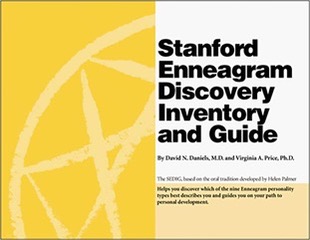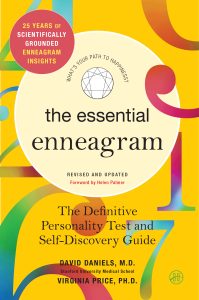The Stanford Enneagram Discovery Inventory and Guide
The Stanford Enneagram Discovery Inventory and Guide was developed by Stanford University researchers David N. Daniels, M.D. and Virginia A. Price, Ph.D.
 The Stanford Enneagram Discovery Inventory and Guide was developed by Stanford University researchers and Enneagram experts, Dr. David N. Daniels, M.D. and Virginia Price, Ph.D. in 1998. It was originally published by Mind Garden in 1998 as The Stanford Enneagarm Inventory and Guide, and renamed the Essential Enneagram Test in 2000.
The Stanford Enneagram Discovery Inventory and Guide was developed by Stanford University researchers and Enneagram experts, Dr. David N. Daniels, M.D. and Virginia Price, Ph.D. in 1998. It was originally published by Mind Garden in 1998 as The Stanford Enneagarm Inventory and Guide, and renamed the Essential Enneagram Test in 2000.

In 2000 the Stanford Enneagram Discovery Inventory and Guide was re-titled, The Essential Enneagram: The Definitive Personality Test and Self-Discovery Guide and published by Harper Collins. It was then revised and updated by Harper Collins in 2009 and in 2025, the 25th year is being celebrated with an audio book version. It is the first scientifically (and still remains one of the only) validated Enneagram tests.
To learn more about David Daniels life-long work, read David N. Daniels Formal Bio.
You can take the The Essential Enneagram Test (formally The Stanford Enneagram Discovery Inventory and Guide) in two ways:
1. Online for $10 at The Narrative Enneagram (TNE) >>
2. Or, by buying the book, The Essential Enneagram, on AMAZON >>
Validity of the Essential Enneagram Test
David Daniels, M.D. and Virginia Price, Ph.D. designed a simple paragraph test based on logical constructs of the nine Enneagram personality types derived from the work of Helen Palmer and David Daniels on the cluster of nine patterns. Each paragraph includes:
-
the overall world view of the type
-
the attentional style
-
the dominant mental and emotional biases
-
the central preoccupations
-
the positive attributes of the type
Daniels and Price asked representatives of each personality type (confirmed to be their type) to review and revise their respective paragraphs to ensure that the paragraphs were congruent with their actual experience of being that type. Daniels and Price then reviewed their revisions to ensure that the paragraphs were accurate conceptually and were equally socially desirable.
Daniels and Price established the Essential Enneagram Test’s (originally the Stanford Enneagram Discovery Inventory and Guide) validity by testing 970 participants across the United States who enrolled in Enneagram classes or volunteered for typing interviews. These participants were unfamiliar with the Enneagram and did not know their Enneagram personality type. 65% of the sample were women. 35% percent were men.
Daniels and Price compared each individual’s Essential Enneagram Test self-rating to one of two “gold standard” ratings:
-
Expert Enneagram Rater: One of the gold standards used was diagnostic typing interviews conducted by certified Enneagram teachers who did not know how the individuals had rated themselves.
-
Enneagram Course Enrollment: The other gold standard was the individual’s own re-evaluation on the Assessment Inventory after taking a 10-week Enneagram course or its equivalent.
Both gold standards produced similar results. These results were used to indicate the validity of the Essential Enneagram Test – the probability that users will accurately select their personality type from among the nine paragraphs.
Daniels and Price analyzed the results for each of the nine paragraphs separately. Each of the nine paragraphs, or personality types, has its own probability of accurately discriminating among the nine Enneagram personality types. The Type Determination pages in The Essential Enneagram book, available on AMAZON, show the validity of each paragraph. For example, the Type 1 paragraph has a 66% validity and the Type 9 has a 68% validity. This means that two-thirds of the people who selected these paragraphs as their type were also identified as this type by the gold standard – either by an expert’s rating through a structured interview or by their own re-evaluation of themselves following an Enneagram course. The break-down on the validity of each type can also be found in The Essential Enneagram book.
There are various look-a-like types in the Enneagram: Type 1 and 4, Type 1 and 6, Type 2 and 4, Type 2 and 9, Type 3 and 7, Type 4 and 5, type 5 and 9, and Type 6 (counter-phobic) and 8. People sometimes choose a paragraph in the Essential Enneagram Test that is there look-a-like type and is not their correct personality type. There are also four types that connect to our dominant type: the two wings and the stress and security points. People sometimes choose one of these four connections, for example Type 3, could choose Type 2 or 4 on the wings or Type 6 (security) and 9 (stress). The online Essential Enneagram Test has steps for discerning which of the look-a-likes is yours.
The Essential Enneagram Statistical Analyses
Each Enneagram paragraph was analyzed with respect to sensitivity (SENS), specificity (SPEC), predictive value of positives (PVP), predictive value of negatives (PVN), test efficiency (EFF), and Cohen’s Kappa test for intraclass correlation. Kappa statistics were computed for the Essential Enneagram test across all 9 scales to measure overall test concordance. Test validity as measured by congruency of respondents’ answers to the gold standard (Expert Rater or Course Enrollment) were statistically and clinically significant. The overall Kappa for the entire test was 0.5254 (p<0.0001), which is a significant degree of concordance. All analyses of individual items displayed concordance or intra-class correlations significant at p<0.0001. In addition, reliability analysis was performed with a small naïve group (n=62) of graduate students. Alternate versions of the inventory were given in the main four weeks apart without introduction of the Enneagram or other bias. This analysis also revealed a significant concordance, Kappa=0.589 (p<0.0001)


